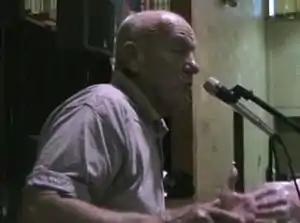Carl Kabat
Carl Kabat (born October 10, 1933 in Scheller, Illinois[1][2]) is a priest of the Catholic order Missionary Oblates of Mary Immaculate who is best known for his eccentric, nonviolent protests against nuclear weapons. He has served over 17 years total in prison over his lifetime.[2][3]

Carl has spent a lifetime witnessing for peace. September 9, 1980: Daniel Berrigan, Jesuit priest, author and poet from New York City; Philip Berrigan, father and co-founder of Jonah House in Baltimore, MD; Dean Hammer, member of the Covenant Peace Community in New Haven, CT; Elmer Maas, musician and former college teacher from New York City; Carl Kabat, Oblate priest and missionary; Anne Montgomery, Religious of the Sacred Heart sister and teacher from New York City; Molly Rush, mother and founder of the Thomas Merton Center in Pittsburgh and John Schuchardt, ex-marine, lawyer, father and member of Jonah House, entered the General Electric Re-entry Division[4] in King of Prussia, PA where Mark 12A reentry vehicles were made.
They hammered on two reentry vehicles, poured blood on documents and offered prayers for peace. They were arrested and initially charged with over ten different felony and misdemeanor counts. In February 1981, they underwent a jury trial in Norristown, Pennsylvania. During their trial they were denied a "justification defense" and could not present expert testimony. Due to the Court's suppression of individual testimony about the Mark 12A and U.S. nuclear war-fighting policies, four left the trial and returned to witness at G.E. They were re-arrested and returned to court. They were convicted by a jury of burglary, conspiracy and criminal mischief and sentenced to prison terms of five to ten years. They appealed and the Pennsylvania Superior Court reversed their convictions in February 1984. The Commonwealth of Pennsylvania then appealed that decision. Following a ruling in the fall of 1985 by the Pennsylvania Supreme Court in favor of the Commonwealth on certain issues (including the exclusion of the justification defense), the case was returned to the Superior Court Appeals Panel. In December 1987, the Superior Court of Pennsylvania refused their appeal, but ordered a re-sentencing. This ruling, however, was appealed to the Pennsylvania Supreme Court. In February 1989 the Pennsylvania Supreme Court denied a hearing of any further issues in the case, and on October 2, 1989 the U.S. Supreme Court announced it would not hear the Plowshares Eight Appeal.
On April 10, 1990 the Plowshares Eight were resentenced by the Pennsylvania Court of Common Pleas in Norristown and, with neither the prosecutor nor G.E. making any recommendations or asking reparations, paroled for up to 23 and 1/2 months in consideration of time already served in prison. Judge James Buckingham listened attentively to statements by defendants, attorney Ramsey Clark, Dr. Robert J. Lifton, and Professors Richard Falk and Howard Zinn, placing the "crime" in the context of the common plight of humanity, international law, America’s long tradition of dissent, and the primacy of individual conscience over entrenched political system.[5]
In 2009, the New York Times carried an informative article about Fr. Kabat's continued crusade against nuclear weapons after he protested at a Minuteman missile site outside of Greeley, Colorado.[6]
On July 4, 2011 and again on July 4, 2012, Fr. Carl Kabat entered the property at a nuclear bomb plant under construction in Kansas City, MO He named his action the 85% Pruning Hooks action – the title stems from the fact that the plant produces approximately 85% of the non-nuclear components for our nation’s nuclear weapons. Fr. Kabat also has re-styled Independence Day as “Interdependence Day” in honor of the interconnection of all nature.[7]
On December 13, 2013, with five other protesters, Kabat was found guilty of trespassing on the relocated National Nuclear Security Administration's Kansas City Plant but was given the unusual sentence of writing essay responses to questions posed by the judge.[8]
See also
References
- Dennis Sadowski. Oblate Father Carl Kabat: ‘A fool for Christ’ Catholic News Service, October 12, 2009.
- Stefene Russell. If I Had a Jackhammer St. Louis Magazine, December 2010.
- Dan Frosch. As Battlefields Shift, Old Warrior for Peace Pursues the Same Enemy New York Times, September 7, 2009.
- https://www.minutemanmissile.com/documents/GEReentryVehicles.pdf
- http://mpalecek.blogspot.com/2009/08/carl-kabat-american-hero-we-have-never.html
- https://www.nytimes.com/2009/09/07/us/07activist.html?_r=0
- http://omiusajpic.org/2012/07/12/fr-carl-kabat-returns-to-kansas-city/
- Megan Fincher. Trial of anti-nuclear activists ends with unusual sentence National Catholic Reporter. December 30, 2013.